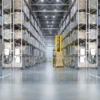De wereld van logistiek en supply chain management ondergaat een revolutie, gedreven door technologische vooruitgang die de manier verandert waarop bedrijven hun activiteiten beheren en optimaliseren. In de nieuwste aflevering van onze podcast Beyond Threads verkennen we een van de belangrijkste aspecten van deze transformatie: innovatie in softwareoplossingen voor opslag en logistiek. Lees verder voor belangrijke inzichten van onze deskundige gasten over hoe bedrijven de curve voor kunnen blijven: Kevin Paindeville, directeur Warehouse Solutions and Innovation bij Bleckmann, en Bart Gadeyne, oprichter van Optioryx.
De evolutie van software in warehousing
Het softwarelandschap in de logistiek heeft zich in de loop der jaren sterk ontwikkeld, zoals Kevin uitlegde. “Als we kijken naar de tijdlijn van de software-evolutie in de logistiek, dan is het allemaal begonnen met pen en papier,” zei hij. “Toen kwamen magazijnbeheersystemen (WMS) en transportbeheersystemen (TMS), die een grote sprong voorwaarts betekenden.”
Kevin merkte ook op dat recentere ontwikkelingen, zoals de overstap naar 'microservices', nog meer flexibiliteit mogelijk maken. Deze microservices, die toegankelijk zijn via API's, stellen bedrijven in staat om hun activiteiten aan te passen en te optimaliseren op een manier die niet mogelijk is met een 'monolithisch' WMS of TMS. Er zijn veel voordelen verbonden aan deze meer op maat gemaakte aanpak.
Alleen naar audio luisteren
Hoe software logistieke innovatie stimuleert
Omdat magazijnoperaties steeds complexer zijn geworden, speelt software een centrale rol in het helpen van bedrijven om efficiënter en nauwkeuriger te werken. Kevin benadrukte hoe software is geëvolueerd van het simpelweg bijhouden van magazijnactiviteiten, zoals voorraadbeheer, naar het optimaliseren ervan. “Of het nu gaat om voorraadbeheer, het verkorten van loopafstanden of het verbeteren van de pickproductiviteit, software vormt de kern van alles,” zei hij. En voor bedrijven als Bleckmann maakt het gebruik van geavanceerde software het mogelijk om betere beslissingen te nemen en flexibeler te reageren op veranderende behoeften van klanten.
Het verhaal van Optioryx: Logistiek revolutioneren met AI
Onze tweede gast, Bart Gadeyne, deelde een aantal manieren waarop zijn bedrijf AI-gestuurde software gebruikt om logistieke uitdagingen aan te pakken. “Logistieke dienstverleners gebruiken vaak een WMS, maar deze systemen missen soms echte intelligentie”, legde hij uit. “Dat is waar Optioryx om de hoek komt kijken.” Optioryx' op AI gebaseerde WMS-uitbreidingen omvatten oplossingen zoals slotting-optimalisatie, picking-optimalisatie en 3D-ladingsopbouw. Een opvallende is de mobiele maatvoeringsapp van het bedrijf. Hiermee kunnen bedrijven snel productafmetingen vastleggen met behulp van een smartphone of tablet - waardoor het proces veel toegankelijker en kosteneffectiever wordt.
Samenwerken met Optioryx voor geoptimaliseerd fulfilment
De afgelopen jaren heeft Bleckmann de AI-oplossingen van Optioryx gebruikt om magazijnprocessen te stroomlijnen. Het eerste probleem dat werd opgelost? Het verkleinen van de loopafstanden om sneller te kunnen leveren. Twee jaar geleden, voor de Black Friday rush, ging Bleckmann samenwerken met Optioryx om dit te bereiken in een van onze Britse magazijnen.
Door gegevens te analyseren en AI-gestuurde strategieën te implementeren, konden ze de loopafstanden met 20% verminderen, wat resulteerde in een productiviteitsstijging van 11%. “Deze verbetering is sindsdien uitgerold naar andere Bleckmann magazijnen,” voegt Kevin toe. “Het is een prachtig voorbeeld van hoe AI tastbare resultaten kan opleveren in echte toepassingen.”
De toekomst van logistieke software
Bart concludeerde dat de verschuiving naar microservices en automatisering zal vereisen dat logistieke dienstverleners flexibeler worden in het voldoen aan de specifieke behoeften van hun klanten. “Sommige klanten zullen volledige automatisering nodig hebben, terwijl andere meer baat zullen hebben bij bepaalde optimalisatieoplossingen,” concludeerde hij. “Het gaat erom elk geval afzonderlijk te evalueren.”
De innovatie in de logistiek gaat steeds sneller en bedrijven die op de hoogte blijven van de nieuwste ontwikkelingen op het gebied van software zullen beter gepositioneerd zijn om te gedijen in een steeds concurrerender markt. Of het nu gaat om het inzetten van AI voor pickoptimalisatie of het omarmen van cloudtechnologie voor grotere schaalbaarheid, de toekomst van warehousing is onmiskenbaar digitaal.
Transcript
Erik Janssen Steenberg: Hallo, en welkom bij de Beyond Threads-podcast van Bleckmann. Mijn naam is Erik Janssen Steenberg. Ik ben vandaag uw gastheer en ik ben erg blij dat u er bent. We hebben een podcast vol actie voor u met een aantal spannende onderwerpen en discussies. Of u nu thuis op de bank zit, in de auto op weg naar uw werk of op kantoor, het is fijn dat u erbij bent, dus laten we beginnen.
In alle afleveringen van Behind Threads gaan we dieper in op actuele onderwerpen om u op de hoogte te houden van alle ontwikkelingen in de logistieke sector. Vandaag hebben we een bijzonder spannend onderwerp, want we gaan dieper in op innovaties. Wat is er nodig om relevant te blijven in logistiek, supply chain management en fulfilment? En wat moeten we doen om ervoor te zorgen dat we de ontwikkelingen in onze sector bijhouden? Vandaag ben ik in gesprek met Kevin Paindeville, Bleckmanns eigen directeur Warehouse Solutions and Innovations.
Welkom, Kevin.
Kevin Paindeville: Bedankt voor de uitnodiging. Leuk om hier te zijn.
Erik Janssen Steenberg: Graag gedaan. Onze tweede gast is Bart Gadeyne van Optioryx. Bedankt voor je komst vandaag.
Bart Gadeyne: Bedankt voor de uitnodiging. Ik ben erg enthousiast om hier te zijn.
Erik Janssen Steenberg: Graag gedaan. Vandaag hebben we het over softwaresystemen in de logistiek. Kevin, kun je om te beginnen een kort overzicht geven van wat die innovaties in softwaretoepassingen zijn en misschien beginnen met een korte introductie van jezelf?
Kevin Paindeville: Zoals je al zei, mijn naam is Kevin en ik werk al vier jaar bij Bleckmann. Ik ben verantwoordelijk voor het ontwerpen en innoveren van magazijnoplossingen en ik werk al meer dan 15 jaar in de logistiek. Ik probeer bedrijven te helpen hun activiteiten te optimaliseren en te stroomlijnen.
Terugkomend op je vraag: als je naar de tijdlijn kijkt, begon de evolutie van software in de logistiek met pen en papier. Daarna zagen we een evolutie, waarbij speciale software voor dit doel werd ontwikkeld. Het zogenaamde magazijnbeheersysteem, transportbeheersysteem.
Dat zijn monolithische applicaties die erg nuttig zijn en een grote sprong voorwaarts betekenden ten opzichte van de pen-en-papier-werkwijze. De afgelopen jaren hebben we een revolutie gezien waarbij leveranciers van WMS en TMS al die functies die in monolithische software waren ingebouwd, als afzonderlijke functies aanbieden, de zogenaamde... Je kunt het via API oproepen en feedback ontvangen. De zogenaamde microservices-aanpak. Dat is een evolutie die we zien en opmerken, en het is een geweldige evolutie.
Erik Janssen Steenberg: Je maakt me oud, want ik kan me nog herinneren dat ik met pen en papier het magazijn in ging als ik iets wilde zien.
Voel je niet zo oud. Er zijn nog steeds magazijnen waar pen en papier worden gebruikt en waar WMS en monolithische transportmeetsystemen worden gebruikt. We hebben er maar een paar gezien die op microservices gebaseerde software gebruiken, dus voel je niet oud.
Erik Janssen Steenberg: Nee, maar de ontwikkelingen gaan erg snel.
Kevin Paindeville: Klopt.
Erik Janssen Steenberg: En steeds sneller.
Welke rol speelt software momenteel bij het verbeteren van de logistiek en opslag voor onze klanten en in de sector als geheel?
Kevin Paindeville: Als je eerst kijkt naar de sprong van pen en papier naar het gebruik van WMS in het magazijn, ben je begonnen met het registreren van elke actie in je magazijn om je voorraad, de processen, de productiviteit, enzovoort bij te houden. Je wordt je meer bewust van wat er werkelijk gebeurt in je magazijn. Sinds de afgelopen jaren draait de evolutie vooral om optimalisatie. Je kunt echt het maximale uit je magazijn halen.
Erik Janssen Steenberg: Juist, dus het begint met weten wat je niet weet, je meer bewust worden en dat vervolgens toepassen in je eigen voordeel. Oh, dat is... Oké.
En natuurlijk heeft Optioryx daarbinnen bij Bleckmann een rol gespeeld. We hebben het geluk dat we vandaag een vertegenwoordiger van Optioryx bij ons hebben. Bart, kun je jezelf even voorstellen en uitleggen wat Optioryx precies doet en hoe ze bedrijven als Bleckmann helpen?
Bart Gadeyne: Natuurlijk. Ik ben Bart, oprichter van Optioryx. Ik heb een achtergrond in algoritmeontwikkeling. De afgelopen 10 tot 15 jaar heb ik me gericht op het introduceren van algoritmeontwikkeling in de logistieke sector en het realiseren van die waardevolle cases. En twee jaar geleden heb ik samen met Vic en Gilles Optioryx opgericht. Daar richten we ons specifiek op het optimaliseren van de warehousing-sector. Om precies te zijn: we helpen bedrijven zoals Bleckmann om de productiviteit van het orderpicken te verhogen en om minder lucht te vervoeren in dozen, op pallets en in vrachtwagens. En om masterdata op een gebruiksvriendelijkere manier te verzamelen.
Erik Janssen Steenberg: Ja, waar vroeger ‘alsjeblieft’ en ‘dank je wel’ de toverwoorden waren, is dat tegenwoordig inderdaad ‘algoritme’. Je hoort het woord overal. Het is dus goed om je te kennen, want voor mij is het nog steeds Chinees. Maar hoe zorgt Optioryx dan voor een revolutie in de logistiek met zijn software?
Bart Gadeyne: Kevin heeft het al genoemd. Logistieke dienstverleners maken doorgaans gebruik van magazijnbeheersystemen. Maar vaak hebben deze systemen intelligentietekorten. Ze gebruiken veel bedrijfsregels om de bedrijfsvoering te stroomlijnen. Maar soms ontbreekt het aan optimalisatievermogen. En dat kost logistieke dienstverleners veel geld. En daar komen wij om de hoek kijken. We hebben een technisch georiënteerd team dat zich richt op de AI-component. We ontwikkelen AI-add-ons om die processen te stroomlijnen en efficiënter te maken. Om maar een paar problematische processen te noemen die we hebben geïdentificeerd.
Allereerst slotting. Dat is het plaatsen van de SKU's, de producten, op een specifieke locatie-ID. Als je dit niet correct doet, krijg je lange loopafstanden. En AI kan daar een rol spelen.
We kunnen bestelpatronen detecteren door niet alleen naar de verkooprotatie te kijken, maar ook naar de correlatie tussen artikelen. Neem bijvoorbeeld schoenen en sokken. Die worden in de mode-industrie vaak samen verkocht, dus ja, het is beter om ze bij elkaar te zetten. Het klinkt heel eenvoudig, maar als je duizenden SKU's hebt, wordt het big data en dan heb je geavanceerde algoritmen of AI nodig om dat op te lossen.
Het tweede is het optimaliseren van het picken, dus het groeperen van bestellingen. Als je dit baseert op bedrijfsrollen, krijg je lange loopafstanden. Hetzelfde geldt voor verpakkingen, dus daar hebben we 3D-algoritmen voor het laden van vracht om aanbevelingen voor dozen te doen. We doen hetzelfde in vrachtwagens.
En last but not least hebben we gezien dat het verzamelen van masterdata erg belangrijk is, dus afmetingen, stapelbaarheidsklassen, breekbaarheid, enz. om de andere processen te kunnen optimaliseren. Maar ja, de systemen die momenteel worden gebruikt, waren vrij duur en niet zo gebruiksvriendelijk, dus daarvoor hebben we ook een product ontwikkeld.
Erik Janssen Steenberg: En specifiek over uw laatste voorbeeld. Dat raakt echt een gevoelige snaar bij mij, omdat ik heb gezien dat zelfs de zeer grote merken waarmee we werken, of merken waarmee we niet werken, zeer goed geïnformeerd zijn over hun producten, wat ze verkopen en hoe ze die willen verkopen. Maar ze zijn veel minder goed op de hoogte of geautomatiseerd als het gaat om het vastleggen van het gewicht, de afmetingen en de kenmerken van hun eigen producten. Dus ik denk dat dat een enorme gamechanger is voor bedrijven als Bleckmann.
Bart Gadeyne: Absoluut.
Erik Janssen Steenberg: Bart, kun je een specifiek voorbeeld geven van hoe jullie software een proces of delen van processen binnen een Bleckmann-magazijn heeft veranderd?
Bart Gadeyne: Ja, om verder in te gaan op wat je zei over masterdata. Dat is een pijnpunt waar elk bedrijf mee te maken heeft. Ik ben er dan ook erg trots op hoe we dat hebben aangepakt. We hadden deze verpakkingsaanbevelingen, maar om die te kunnen uitvoeren, heb je de juiste masterdata nodig. Klanten wilden verder met het optimaliseren van producten, maar beschikten niet over de benodigde data.
Dan ga je op zoek naar alternatieven, om eerlijk te zijn. Je kunt handmatig metingen doen met het oude meetlint, maar dat is niet ideaal. Dat kan ik me nog goed herinneren. Of je kunt kiezen voor de duurdere statische meetapparatuur, die nogal kapitaalintensief is. Ik zie ons team nog zitten in de kroeg om de hoek bij het kantoor. We dachten: hoe kunnen we deze klanten helpen? Want een probleem voor hen is een probleem voor ons.
En plotseling, na een paar biertjes, zag mijn medeoprichter Vic het licht. De beroemde Ballmer Peak. Je hebt er een voor coderen. Maar je hebt ook een Ballmer Peak voor creatief denken. Hij had dus een moment van inspiratie over hoe hij de eerste mobiele app voor het opmeten van afmetingen kon maken. Dus we zeiden: ‘Hoe lang gaat dat duren?’ Hij zei: ‘Twee weken ontwikkelingstijd.’ En zes maanden later was hij eindelijk klaar met de app. Maar hiermee kun je heel eenvoudig masterdata vastleggen door gewoon rond te lopen met een mobiele telefoon of een iPad. Hoe werkt dit in de praktijk? Meestal wordt het gebruikt bij inkomende goederen. Wanneer er een nieuwe SKU binnenkomt, loop je een soort checklist door. Van welke leverancier is het? Wat zijn het gewicht en de afmetingen? Is het breekbaar, is het stapelbaar of niet? Maar we zien dat het in allerlei processen wordt gebruikt. Ook bij uitgaande operaties, om de verzendkosten van een pallet te berekenen. Tegenwoordig stijgen de volumetrische transporttarieven. Dat is ook een pijnpunt. En als je geen statische dimensioner hebt, kun je rond de pallet lopen, deze scannen en onmiddellijk die afmetingen vastleggen om het tarief en het factuurbedrag te berekenen. Het wordt ook gebruikt in ziekenhuizen, dus het heeft een breed scala aan gebruiksmogelijkheden.
Erik Janssen Steenberg: Dat betekent ook dat het zeer nauwkeurig is. Anders zou het niet mogen worden gebruikt in een ziekenhuisomgeving. Nu terugkomend op het vastleggen van gegevens bij inkomende goederen. Onderschat de impact niet, want vergeet niet dat de producten die we verzenden, eigendom zijn van onze partners, de merken. Hoewel zij veel tijd en geld besteden aan het ontwerpen van hun producten, hebben zij dat exacte product nooit in handen gehad wanneer wij het ontvangen. Wij zijn degenen die daadwerkelijk zorgen voor de kwaliteit en kwantiteit van het product. En met uw tooling kunnen we dat veel beter, veel nauwkeuriger en op een snellere en kostenefficiëntere manier doen. Ik zie dus zeker de voordelen ervan.
Kevin, kun je iets meer vertellen over de casestudy of businesscase van Bleckmann rond het succesverhaal met Optioryx?
Kevin Paindeville: Natuurlijk. We hadden het er een paar jaar geleden over, ik denk dat het twee jaar geleden was, en we ontmoetten Bart, Vic en Gilles voor het eerst in een van onze magazijnen in België. Het was vlak voor Black Friday. We waren aan het brainstormen over een aantal mogelijke use cases.
Bart Gadeyne: Ik herinner het me nog goed. Ik was bezig met het pitchen van de laadcapaciteit en Kevin zei: 'Dat hebben we hier niet nodig. We hebben modeproducten, dat is niet zo interessant.'
Kevin Paindeville: Maar toch kwamen we op het idee waarbij ik zei: 'Oké, we innoveren en automatiseren nog steeds, maar we hebben nog steeds veel handmatige handelingen. En het zou heel fijn zijn als we de loopafstand van onze orderverzamelaars kunnen optimaliseren. Als je kijkt naar het pickproces, naar de literatuur en ook naar de database, dan wordt 50 of 60 procent van de picktijd besteed aan lopen. Als we dat kunnen verminderen...
Nogmaals, dat is de reden waarom de goods-to-man-oplossing in automatisering zo ontzettend populair is. Maar voor onze klanten die nog steeds handmatig werken, is er een kans om winst te boeken. Dus we hebben tijdens die vergadering een beetje gebrainstormd en toen zei Bart: Laten we daar eens over nadenken en er later op terugkomen. En ik geloof dat je een hackathon of iets dergelijks hebt georganiseerd.
Bart Gadeyne: Ja, we waren op een teambuildinguitje en op een dag besloten we deze kwestie aan te pakken. We hebben ook wat gegevens van jullie gekregen en toen hebben we het hele team erop gezet. We hebben geen volledige oplossing gevonden, maar wel een goed begin. Laten we het zo noemen.
Erik Janssen Steenberg: Maar gezien de huidige ontwikkelingen op de arbeidsmarkt is het een heel goed idee om nauw samen te blijven werken met Gilles en zijn team, en met Bart. Want de krapte op de arbeidsmarkt gaat niet weg, dus hoe meer we kunnen compenseren op het vlak van reisafstanden, hoe beter het voor ons is.
Kevin Paindeville: Een paar weken later kwamen ze terug en zeiden: 'Kijk, dit is het resultaat. Het is nog niet definitief, maar we willen jullie alvast wat inzichten geven. We hebben de eerste simulaties op basis hiervan bekeken en zien hier een enorm potentieel. Dus hebben we wat meer analyses gedaan. We hebben een businesscase gemaakt. Die hebben we intern gepresenteerd. We kregen goedkeuring van de projectraad om door te gaan. En vorig jaar hebben we het, geloof ik, bij een eerste klant in het Verenigd Koninkrijk geïmplementeerd. Daar zagen we enorme besparingen en een enorm potentieel.
Om u wat cijfers te geven: we zagen voor die specifieke klant een besparing van wel 20% op loopafstanden. Niet voor één persoon, maar in het algemeen...
Erik Janssen Steenberg: Nee, de totale operatie.
Kevin Paindeville: Een besparing van 20% betekent niet dat de productiviteit met 20% toeneemt. Zoals ik al zei, bestaat 50% of 60% van de orderverzameltijd uit lopen. Maar toch heb je een potentiële productiviteitsstijging van 10% tot 11%. We hebben een pilot gedaan en dat geverifieerd, en dat is precies wat we hebben gekregen: een productiviteitsstijging van 11%.
Bart Gadeyne: Ook tijdens de pilot is het altijd belangrijk om de theorie af te stemmen op de praktijk. Je kunt namelijk wel iets berekenen, maar vertaalt zich dat ook naar de werkelijkheid? Daarom zijn we begonnen met iemand te volgen met een meetwiel en een stopwatch om te controleren of het zich vertaalt naar de praktijk. We volgden dus één persoon die bezig was met het picken. En we zagen dat het overeenkwam met wat we in gedachten hadden. Vervolgens hebben we één persoon live op het systeem gezet. De optimalisatie kwam ook min of meer overeen. Toen dachten we: ‘Laten we vijf mensen live op het systeem zetten.’ We zagen hetzelfde. Vervolgens hebben we het hele magazijn gedaan en hun orderverzamelproductiviteit nam stap voor stap toe. Dat was mooi om te zien. Nu zitten we in de uitrolfase en proberen we hetzelfde systeem in veel magazijnen uit.
Erik Janssen Steenberg: Nou, als je tot 4.000 mensen in magazijnen hebt die picken, verpakken, enzovoort, is een verbetering van 12% niet mis.
Bart Gadeyne: En daar blijft het niet bij, Erik. We hebben nog een andere functie, omdat we de ordergroepering willen optimaliseren. Als je 20 bestellingen in één pickroute groepeert, is het goed om dat op een effectievere manier te doen. We zien daar zeer grote voordelen. Dus dat doen we parallel. En later gaan we ons richten op de optimalisatie van de slotting.
Erik Janssen Steenberg: Oké jongens, als jullie vooruitkijken, welke specifieke trends zien jullie dan opkomen in de logistiek en in logistieke software?
Kevin Paindeville: Een van de trends heeft alles te maken met cloudtechnologie op locatie, maar met de cloud kun je direct je capaciteit vergroten. Ook digitaal, waar je je processen in virtual reality kunt simuleren en de dag kunt herhalen, enkele virtuele wijzigingen kunt aanbrengen en kunt zien wat de impact is. Dat bespaart veel tijd in plaats van een wijziging door te voeren, een week te wachten en naar de cijfers te kijken. We kunnen de scène digitaal afspelen en de impact zien.
Bart Gadeyne: Tegenwoordig worden logistieke dienstverleners overweldigd door de mogelijkheden op het gebied van automatisering. Op een gegeven moment werkt het niet voor alle activiteiten of alle SKU's. Je hebt de microservices waar we het over hadden. En ik denk dat het voor logistieke dienstverleners gewoon heel belangrijk is om over al die kennis te beschikken.
Dus als er een nieuwe modeklant binnenkomt en je kijkt naar het orderprofiel: wat hebben we hier nodig? Hebben we automatisering nodig? Hebben we optimalisatie nodig? Soms kunnen die twee hand in hand gaan, maar die mogelijkheid is essentieel om een zeer goede logistieke dienstverlener te zijn. Ik denk dat Bleckmann die mogelijkheid op dit moment heeft. Dus ik denk dat jullie op de goede weg zijn.
Erik Janssen Steenberg: Oké heren, hartelijk dank voor jullie inzichten. Naar mijn bescheiden mening was het een zeer interessant gesprek. We hebben veel geleerd. Bart? Als leden van ons publiek willen praten over jullie producten of de hulp die jullie kunnen bieden, hoe kunnen ze dan contact met jullie opnemen?
Bart Gadeyne: We plaatsen af en toe wat content, voornamelijk over use cases en de optimalisatiecases die we doen. Ga naar onze website optioryx.com, of volg ons op LinkedIn.
Dezelfde vraag voor jou, Kevin. Als ons publiek meer wil weten over wat er bij Bleckmann gebeurt of hoe we hen kunnen helpen zich aan te passen aan de steeds veranderende sector waarin we actief zijn, hoe kunnen ze dan contact met je opnemen?
Kevin Paindeville: Hetzelfde antwoord. Op onze website plaatsen we enkele use cases en dingen die we doen op het gebied van innovatie. Als ze specifieke vragen hebben, kunnen ze natuurlijk contact met mij opnemen via LinkedIn. En als je niet weet met wie je contact moet opnemen binnen het Bleckmann-team, ga dan gewoon naar onze website en gebruik de links die daar staan.
Erik Janssen Steenberg: Voor degenen die meeluisteren: abonneer je om op de hoogte te blijven van alle ontwikkelingen bij Bleckmann en binnen de sector waarin we actief zijn. Je wordt dan automatisch uitgenodigd voor onze volgende podcast. Nogmaals hartelijk dank voor je deelname vandaag en tot ziens!












